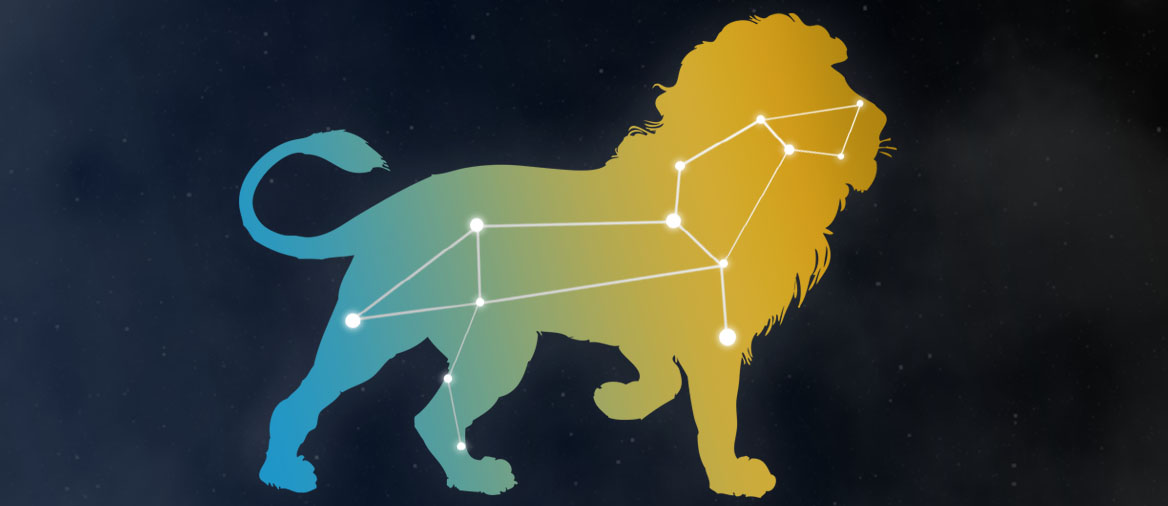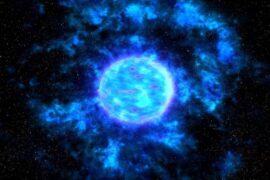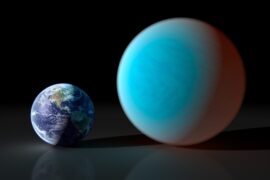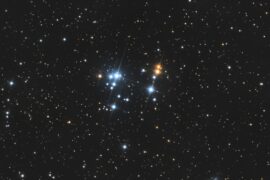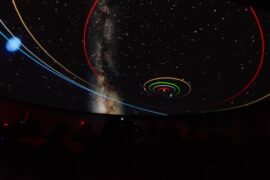Every constellation in the sky holds all kinds of secrets and mysteries for astronomers to discover, not to mention, studying them is one of the easiest ways to start getting into astronomy.
The Leo constellation is no exception. It is a group of stars that looks like a Lion! of course people will want to take a look at it and learn more. That’s the reason we have compiled a list of the most important Leo constellation facts for kids, the details for each one can be found below.
- In the Harry Potter series, Sirius Black’s brother is named after a star in Leo
- Leo contains 13 stars with confirmed planets
- Leo is located between the Cancer and Virgo constellations in the zodiac belt
- Leo is made of 9 main stars
- Leo is one of the oldest constellations
- In Babylonia, Leo was known as ¨´UR GU LA´´
- In astrology, the Sun is considered to be in Leo from July 23 to August 22
- In total, 156 stars are located in Leo
- The main stars in Leo are named after parts of the Lion
- Every year a meteor shower happens in Leo
- Leo has a little brother
Leo Constellation Fact Sheet
| Name Origin | The Lion |
| Astronomical abbreviation | Leo |
| Brightest star | Regulus |
| Main stars | 9 |
| Cataloged stars | 92 |
| Stars with planets | 13 |
| Total stars | 156 |
| Area | 947 square degrees |
| Quadrant | NQ2 |
| Bordering constellations | Cancer Crater Hydra Leo Minor Lynx Sextans Ursa Major Virgo |
| Meteor showers | Leonids |
| Symbol | ♌ |
Leo Facts

1 In the Harry Potter series, Sirius Black’s brother is named after a star in Leo.
It is well known the author of the Harry Potter series, J.K. Rowling liked to name the character in the series after stars and other celestial objects.
The inspiration for Regulus Black, brother of Harry´s godfather Sirius, was taken from the brightest star in Leo: Regulus.
2 Leo contains 22 stars with confirmed planets
Thanks to modern imaging techniques, we are now able to find planets orbiting around distant stars. These planets are very diverse, but most of them, just like the other planets in our Solar System, are unlikely to be able to support life.
At least 22 planets have been confirmed in Leo, but a lot more will probably be discovered in the future.
Here’s a list of the stars that contain confirmed planets in Leo:
| Algieba |
| Rasalas |
| HD 97658 |
| HD 100655 |
| HD 89307 |
| 83 Leo B |
| HD 94834 |
| HD 81040 |
| HD 81040 |
| HD 87646 |
| HD 95089 |
| HD 88133 |
| HD 96063 |
| HD 100777 |
| HD 98736 |
| HD 102272 |
| HD 89345 |
| BD+20 2457 |
| WASP 104 |
| WASP 106 |
| WASP 183 |
| DP Leonis |
3 Leo is located between the Cancer and Virgo constellations in the zodiac belt
The zodiac belt is an imaginary ring of constellations that is roughly aligned with Earth’s orbit. Thanks to this, the constellations in it have a cycle that passes through the Sun.
When a constellation “hides” behind the Sun at a certain point of the year, it is said the Sun is the “house” of that constellation. For example, “in the house of Leo”.
Each constellation has two neighbor constellations, one behind it and one in front of it. The constellation behind Leo is Cancer and the one that follows it is Virgo.
4 Leo is made of 9 main stars
Leo is one of the constellations with the most straightforward shapes. It is only formed by 9 main stars. These stars are in order of brightness:
- Regulus
- Denebola
- Algieba
- Zosma
- Algenubi
- Chertan
- Adhafera
- Al Jabhah
- Rasalas
German illustrator H.A. Rey proposed a second way to visualize Leo that makes the shape of the lion a bit clearer and makes use of 15 stars.
5 Leo is one of the oldest constellations
Because of its clear shape, Leo is one of the constellations that has been recognized for the longest time.
There are records of Mesopotamians depicting the group of stars as a lion as far as 4,000 BC.
Sumerians also recognized the constellation and added their own myths and stories.
6 In Babylonia, Leo was known as “UR GU LA”
Speaking of ancient cultures, Babylonians used the name “UR GU LA” to refer to Leo. These words meant “The Great Lion”.
The main star in Leo, Regulus, was associated with kings.
7 In astrology, the Sun is considered to be in Leo from July 23 to August 22
As mentioned in fact #3, Leo is part of the Zodiac belt. Every month or so one of the constellations in the belt hides directly behind the Sun opposite to Earth.
Leo goes through this phase from August 10 to September 10, however, in astrology these dates are changed a bit and the sign is assigned to people born between July 23 and August 22.
8 In total, 156 stars are located in Leo
Some stars can be seen with your eyes, but when you look with a telescope, more and more become visible.
While ancient cultures were only able to see a few of the stars in Leo, with the help of modern telescopes and image processing techniques, we have been able to find 156 stars inside the area of the constellation.
This number already seems like a lot of stars, but as our technology improves, we will identify more and more stars in the future.
9 The main stars in Leo are named after parts of the Lion
We keep mentioning Leo is one of the constellations that has kept the same shape since the beginnings of recorded history and that had another side-effect. It meant the stars in the constellation were mostly named after the part of the lion each of them represents. Here’s a list of Leo’s 9 main stars and their meanings.
| Star | Meaning |
| Regulus | Prince or Little King |
| Denebola | Tail of the lion |
| Algieba | The Lion’s mane |
| Zosma | Girdle |
| Algenubi | The southern star of the lion’s head |
| Chertan | Ribs |
| Adhafera | The braid |
| Al Jabhah | Forehead |
| Rasalas | The northern star of the lion’s head |
10 Every year a meteor shower happens in Leo
Meteor showers are phenomena where a lot of “shooting stars” occur in short amounts of time. They are caused by comets orbiting around the Sun, and they are very punctual in the sense they happen almost on the exact date every year.
We have an extensive article on comets if you want to learn more.
Thanks to this exact timing, meteor showers also occur inside the same area every time. When that area is inside a constellation, that meteor shower is named after it.
The Leonids occur every year between November 6 and November 20, but they peak on November 17. They are caused by the comet Tempel-Tuttle and every 33 years they are spectacular.
11 Leo has a little brother
Right above Leo there is a small, dim constellation that looks very similar to it. This constellation is named Leo Minor, which means “little lion”. This is one of the smallest constellations in the sky with an area that expands just 232 squared degrees.
List of Stars in Leo

The most prominent star in Leo is Regulus, located about 79 light-years from the Sun.
A star’s brightness is measured by its visible or apparent magnitude, which is its brightness as seen from Earth, It is important to clear this up because this measure is affected by the star’s distance to Earth. For example, a star might be brighter than another, but if it is farther away from Earth, it will look dimmer to us.
A different measure does tell us the real brightness of a star compared to one another. This is called the absolute magnitude.
The following table list the most important stars in the Leo constellation sorted by their magnitude. As you can see, the brighter stars have proper names because they could be seen in the night sky since ancient times. Stars discovered more recently only have their scientific names.
| Name | Alternative name | Type of star | Distance (light-years) | Visible Magnitude |
| Regulus | Alpha Leonis | Quadruple star | 77 | 1.36 |
| Denebola | Beta Leonis | Variable star | 36 | 2.14 |
| Algieba | Gamma Leonis | Binary Star | 126 | 2.37 |
| Zosma | Delta Leonis | A-type star | 58 | 2.56 |
| Algenubi | Epsilon Leonis | G1 star | 251 | 2.97 |
| Chertan | Theta Leonis | A-type star | 178 | 3.33 |
| Adhafera | Zeta Leonis | Third magnitude star | 260 | 3.43 |
| Al Jabhah | Eta Leonis | White supergiant | 2131 | 3.48 |
| Omicron Leonis | Binary star | 135 | 3.52 | |
| Rho Leonis | Binary star | 5719 | 3.84 | |
| Rasalas | Mu Leonis | K-type giant | 133 | 3.88 |
| Iota Leonis | F-type star | 79 | 4 | |
| Sigma Leonis | B-type star | 214 | 4.05 | |
| 54 Leonis | Binary star | 289 | 4.3 | |
| Upsilon Leonis | G-type star | 178 | 4.3 |
The following video can help you visualize how the different stars in Leo are positioned and how their distance affects how we perceive them here on Earth.
Mythology

While the current names of the constellations come from greek mythology, Leo is one of the constellations whose name originated way before them.
Here are some of the names ancient cultures gave to Leo:
- Persia: Shir
- Turks: Artan
- Syria: Aryo
- India: Simha
All of these names can be translated to lion.
Leo stars appearing in myths and stories in Sumeria. They represented Leo as the beast Humbaba who fought and lost to the Sumerian king Gilgamesh in the story that carries his name, The Epic of Gilgamesh.
In Greek mythology, Leo is represented in the myth of theTtwelve labours of Heracles. Heracles is the demigod hero (half god half human) Hercules is based on. This mythical, giant lion lived in Nemea, an ancient part of Greece. The lion had golden, impenetrable fur and Heracles had to use nothing but his strength to defeat him.
Objects visible in Leo with a telescope
If you point a telescope in the direction of Leo, you will find it is also home of many interesting deep-sky objects, especially a bunch of galaxies that can even be identified with a mid-range home telescope (at least around 150mm of aperture). Here’s a list of the ones that are visible from home. There are more, but we are only able to see those with the telescopes used by observatories or in space like the Hubble.
- Galaxy Messier 65
- Galaxy Messier 66
- Galaxy Messier 95
- Galaxy Messier 96
- Galaxy Messier 105
- Galaxy NGC 3628
- Quasar group Clowes-Campusano LQG
- Quasar group U1.11
- Quasar group U1.54
- Quasar group Huge LQG
Famous people born under the sign of Leo
- Arnold Schwarzenegger – July 30
- J.K. Rowling – July 31
- Jason Momoa – August 1
- Tom Brady – August 3
- Barack Obama – August 4
- Neil Armstrong – August 5
- Jennifer Lawrence – August 15
Where to learn more
Here are some resources that will help you learn even more about the Leo constellation if you want to delve deep into a certain aspect of it:
- Complete List of Stars in Leo at Wikipedia
- Leo’s detailed mythology at Ian Ridpath’s Startales
Enjoyed this article?
Get daily 10-minute PDFs about astronomy to read before bed!
Sign up for our upcoming micro-learning service where you will learn something new about space and beyond every day while winding down.

